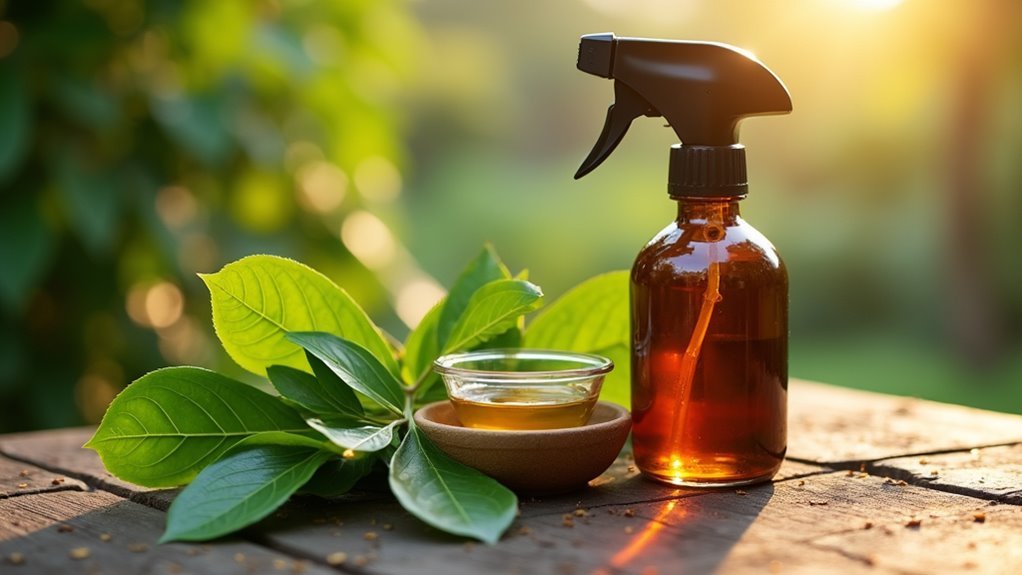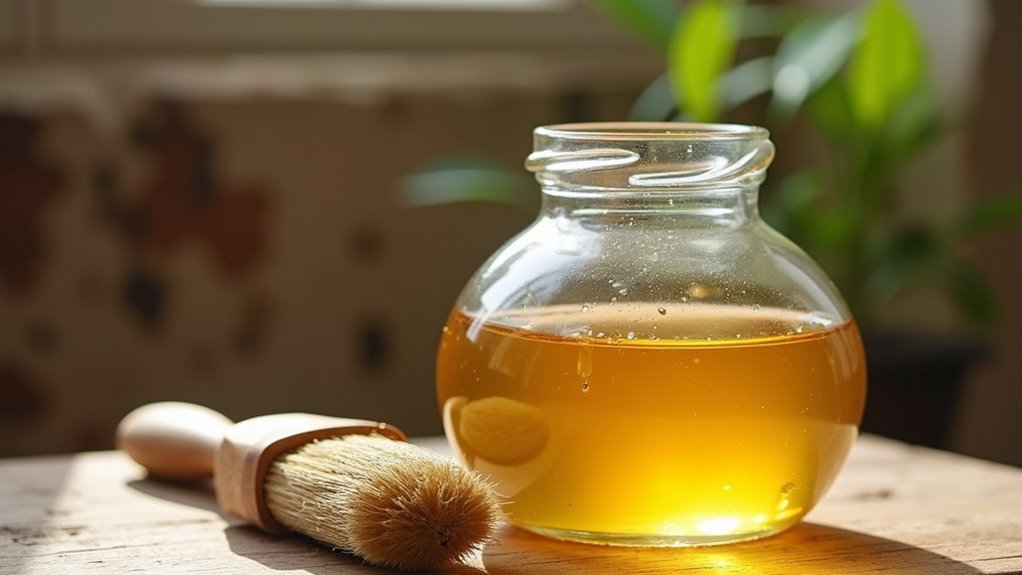You can create an effective homemade neem oil termite treatment by mixing 5mL pure neem oil with 2mL mild liquid soap and 1 liter water. Apply this solution directly to infested wooden surfaces during early morning or evening hours, targeting entry points and hidden areas. Reapply every 3-4 days until termite activity decreases, then maintain prevention with weekly treatments. Always wear protective gear and store solutions in dark containers. These foundational steps will help you master natural termite control methods.
Understanding How Neem Oil Works Against Termites

While synthetic pesticides often come with harsh chemicals and environmental concerns, neem oil offers a natural solution that targets termites through multiple biological pathways.
Neem oil provides an environmentally-friendly alternative to chemical pesticides, naturally disrupting termite biology without toxic side effects.
This biodegradable insecticide contains azadirachtin, which disrupts termites’ hormonal systems, affecting their growth, reproduction, and feeding abilities. When you apply neem oil to infested areas, it penetrates termites’ exoskeletons, causing dehydration and death while simultaneously repelling new invaders.
What makes this approach ideal for effective termite control is its dual action as both repellent and killer. You’ll find it’s nontoxic to humans and safe around pets, making it perfect for residential pest management.
Regular applications help prevent termites from establishing colonies while managing existing populations without harming beneficial insects in your environment.
Essential Ingredients for Your Homemade Neem Oil Termite Spray
Before you can harness neem oil’s termite-fighting power, you’ll need to gather the right ingredients that work together to create an effective spray solution.
The foundation of your DIY neem oil treatment requires 100% pure neem oil as the active ingredient that’ll combat termites in infested areas.
You’ll also need mild liquid soap, which serves as an essential emulsifier to help the neem oil blend properly with water.
Without this emulsifier, the oil won’t distribute evenly, reducing your spray’s effectiveness.
For enhanced results, consider adding natural emulsifiers like Soapnut Powder to create a fully herbal solution.
These simple ingredients—neem oil, liquid soap, and water—form a powerful combination that targets termites while remaining environmentally safe for your home treatment needs.
Step-by-Step Recipe for Effective Neem Oil Termite Treatment

Now that you’ve gathered your essential ingredients, you’ll need to follow precise mixing ratios to create an effective termite treatment.
The application method you choose will directly impact how well the neem oil penetrates infested areas and eliminates termites.
Let’s walk through the complete recipe process, from measuring ingredients to applying your homemade solution.
Essential Ingredients and Supplies
Creating an effective homemade neem oil termite treatment requires just three essential ingredients that you likely already have access to. You’ll need 100% pure neem oil as your active ingredient, mild liquid soap to help emulsify the mixture, and purified water as your base. This combination creates a non-toxic solution that’s safe for your family and pets.
For application, you’ll need a fine mist spray bottle to guarantee even coverage on wooden surfaces and other targeted areas. The liquid soap acts as an emulsifier, allowing the neem oil to mix properly with water rather than separating. Make certain you have measuring tools for precise ratios, as accuracy is vital for effectiveness. Store unused neem oil in a cool, dark location to preserve its potency for future treatments.
Proper Mixing Ratios
Three precise measurements form the foundation of your neem oil termite treatment: 5 mL of pure neem oil, 2 mL of mild liquid soap, and 1 liter of water.
These proper mixing ratios create an effective pest control solution that targets termites while ensuring the oil emulsifies properly.
For maximum effectiveness, follow these essential steps:
- Use your neem oil mixture within 8 hours of preparation to maintain potency
- Shake the solution thoroughly before each application to distribute the oil evenly
- Apply neem during early morning or late evening to avoid UV sensitivity
When dealing with heavily infested areas, increase the neem oil concentration to 10 mL while keeping the soap and water amounts unchanged.
Always target undersides of affected surfaces when you apply neem for ideal termite treatment results.
Application Method Instructions
Before you begin treatment, gather your spray bottle, measuring tools, and protective gear to guarantee a smooth application process.
Shake your neem oil mixture vigorously before each use to prevent separation. Target infested wooden surfaces directly, ensuring you cover both sides of affected wood for maximum termite infestation control.
Focus your application method on entry points where termites typically access your property. Apply the neem oil spray within eight hours of mixing for peak effectiveness.
Unlike expensive pest control companies, this DIY approach requires consistent reapplication every 3-4 days until termite activity decreases.
To prevent future infestations, maintain a preventive schedule by spraying vulnerable areas every 7-14 days, creating a protective barrier against returning termites.
Proper Application Techniques for Maximum Termite Control

Five key steps will guarantee your homemade neem oil treatment delivers maximum termite control effectiveness.
Follow these five essential steps to create a powerful homemade neem oil solution that effectively eliminates termites and protects your property.
First, prepare your solution by combining 5 mL of neem oil with 2 mL of mild liquid soap and 1 L of water in a spray bottle. Shake thoroughly before each use to prevent separation.
Target your application strategically:
- Apply neem oil directly onto infested wooden surfaces and around entry points where termites typically enter
- Spray during early morning or late evening hours to avoid UV sensitivity issues
- Focus on dark, hidden areas where termites commonly reside
Finally, maintain consistent treatment schedules. Reapply treatment every 7-14 days or immediately after heavy rainfall to guarantee continuous protection.
This systematic approach maximizes your termite treatment’s effectiveness while preventing reinfestation.
Optimal Timing and Frequency for Neem Oil Applications
You’ll achieve the best results by applying neem oil during early morning or late evening hours when UV sensitivity won’t reduce its effectiveness.
Your treatment schedule should vary based on the severity of your termite problem – spray every three to four days for active infestations, but reduce frequency to every 7-14 days for preventive maintenance.
Remember that neem oil works gradually, so you won’t see immediate results and should expect to wait at least two days before noticing significant improvement.
Best Application Times
When dealing with termite infestations, timing your neem oil applications correctly can make the difference between success and disappointment. You’ll achieve maximum effectiveness by scheduling your homemade neem oil spray treatments strategically.
Apply neem oil during these ideal windows:
- Early morning or late evening – UV rays degrade neem oil’s active compounds, so avoid midday applications.
- Every 7-14 days for preventive measures – Consistent timing maintains protective barriers against future infestations.
- At least twice weekly for acute infestations – Severe cases require more aggressive scheduling.
Remember that reapplication every three to four days eliminates visible termite activity completely.
Use your prepared spray within 8 hours of mixing to preserve potency.
Skip treatments during rain or extreme temperatures, as these conditions prevent proper absorption and reduce your termite treatment’s effectiveness.
Treatment Schedule Frequency
Establishing a consistent treatment schedule determines whether your homemade neem oil applications succeed or fail against termite colonies. You’ll need different frequencies depending on your situation’s severity.
| Treatment Type | Application Frequency |
|---|---|
| Acute termite infestations | At least twice weekly |
| Intensive treatment | Every 3-4 days |
| Prevention schedule | Every 7-14 days |
| Batch preparation | Use within 8 hours |
| Reapplication timing | Early morning/late evening |
For active infestations, apply homemade neem oil at least twice weekly to reduce pest populations effectively. During intensive treatment phases, reapply neem oil every three to four days targeting remaining termites. To prevent future infestations, schedule neem oil applications every 7-14 days with consistent coverage of affected areas. Always prepare small batches ensuring maximum potency within the eight-hour effectiveness window.
Combining Neem Oil With Other Natural Termite Deterrents
Five powerful natural combinations can greatly boost neem oil’s termite-fighting capabilities beyond what it achieves alone.
You’ll find these termite deterrents work synergistically to create more effective treatments than single ingredients.
Combining neem oil with orange oil creates a potent mixture where d-limonene suffocates termites while neem disrupts their growth.
When you mix neem oil with boric acid, you’ll damage termites’ nervous systems and digestive tracts simultaneously.
- Adding diatomaceous earth introduces abrasive particles that damage termite exoskeletons while accelerating dehydration.
- Mixing with vinegar creates an effective spray that disrupts scent trails and provides preventive protection.
- Combining with saltwater solution increases dehydration effects while maintaining neem’s growth-disrupting properties.
These combinations amplify your homemade treatment’s effectiveness considerably.
Safety Precautions and Storage Tips for Homemade Neem Oil Solutions
Although neem oil is naturally derived and generally safe, you’ll need to follow specific safety protocols when preparing and storing homemade termite treatments.
Despite neem oil’s natural safety profile, proper preparation and storage protocols remain essential for effective homemade termite treatments.
Wear gloves and protective eyewear when handling neem oil to prevent skin irritation, as some people may be sensitive to the oil.
Store your homemade solutions in dark glass or non-reactive plastic containers in cool, dark places to maintain effectiveness. Light and heat can degrade neem oil’s potency quickly.
Label containers with preparation dates and ingredients, since these solutions work best within eight hours of mixing.
Keep all homemade solutions away from children and pets.
Following these storage tips and safety precautions guarantees your non-toxic termite treatment remains effective while protecting everyone in your household.
Frequently Asked Questions
How to Use Neem Oil to Kill Termites Naturally?
Mix 5 mL neem oil with 2 mL mild soap and 1 liter water. Spray directly on infested wood and entry points. Reapply every few days for effective termite elimination.
What Is the Best Homemade Termite Killer?
You’ll find the most effective homemade termite killer combines 5 mL neem oil, 2 mL liquid soap, and 1 L water. Apply this mixture directly to infested areas every few days for best results.
How Do You Make Neem Oil Insecticide?
You’ll mix 5 mL of pure neem oil with 2 mL of mild liquid soap and 1 liter of water. Shake well before using and apply within 8 hours for maximum effectiveness.
What Not to Mix With Neem Oil?
You shouldn’t mix neem oil with synthetic pesticides, bleach, mineral oils, strong acids, or alcohol. These combinations can reduce effectiveness, break down active compounds, cause poor mixing, or disrupt emulsification processes.
In Summary
You’ve now got seven powerful strategies to create and use homemade neem oil treatments against termites. Remember, consistency’s key—stick to your application schedule and don’t skip the safety precautions. While neem oil works effectively for prevention and early infestations, you’ll need professional help for severe termite problems. Store your homemade solutions properly, monitor treated areas regularly, and you’ll maintain a natural defense system that protects your property from these destructive pests.





Leave a Reply